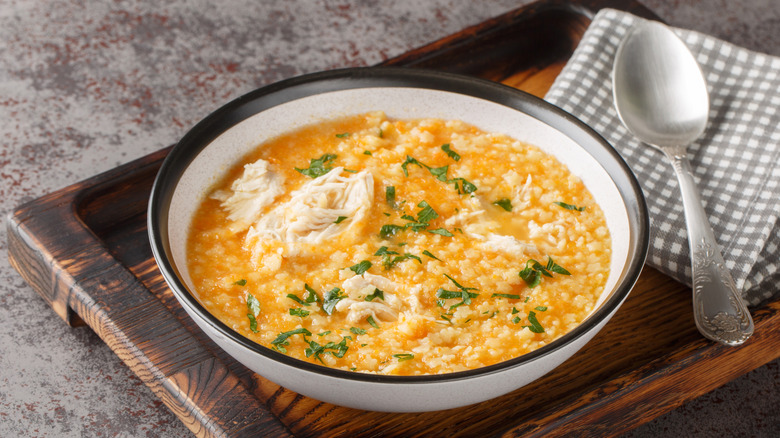Why This Classic Soup Is Referred To As 'Italian Penicillin'
Some Italian dishes have creative names that dress up a defining feature of the food in a cultural reference. The name for Italian wedding soup, for instance, comes from the phrase "minestra maritata," meaning "married soup." It references the marriage of flavors in the soup. Pastina soup is another dish whose nickname follows that pattern. You may know it as Italian Penicillin. Despite what it's called, the main ingredient isn't antibiotics derived from Penicillium mold. Rather, the soup is named for its longtime use as feel-good nourishment when you're sick.
Pastina is one of the smallest kinds of pasta, a collection of little star-shaped wheat nuggets that can easily be mistaken for risotto, or even sometimes couscous. Italian Penicillin is basically a version of chicken noodle or chicken and rice soup. Typical ingredients include chicken stock, chicken, pastina, onions, carrots, and celery — garnished with parmesan cheese, of course. Pastina provides plenty of carbs and chicken stock works it's own magic to help relieve a few cold symptoms.
Pastina is a popular home-cooked meal, especially in the winter and you'll find Pastina Soup on menus at many Italian-American restaurants. For a few good strategies on how to make the best Pastina Soup we've ever had, we consulted Patricia Vega, Executive Chef at Brooklyn supper club, Jr & Son. In an exclusive exchange, she gave us a few great ideas on how to make flavorful, rich Italian Penicillin.
Tips & ingredient swaps for flavorful pastina soup
You need a flavorful broth as a foundation for an epic batch of Italian Penicillin, and Patricia Vega has a few tips for making a rich and multi-layered broth. Before adding pasta or anything else, infuse the broth by simmering it with garlic, bay leaf, and parmesan rind. Then, add onion, celery, and carrot that's already been sauteed in olive oil. "Since it's a simple soup, a flavorful broth is essential," Vega explained. "Use homemade or well-seasoned store-bought stock, (and) salt the broth properly. Don't rely on pastina alone to carry flavor."
Before you add the pastina pasta, add whisked egg into the simmering soup for a creamy, "stracciatella' style," Vega said. You can also combine raw egg with parmesan cheese and then add a little broth to temper the egg mixture before adding it to the soup. (This is a safeguard against accidentally scrambling the egg.) Then, once everything else is in the pot, add the pastina. Vega warned, "It cooks very quickly. Add it at the end and watch it carefully to avoid mushiness."
Avoid using too much pasta because it'll soak up the broth quickly. Vega suggests sticking to ¼–⅓ cup per quart of broth. Use a compound butter or finishing oil to really amp up the complex, comforting qualities of this soup, like a bit of butter or some EVOO. Then, garnish with a little bit more cheese to tie the whole dish together. Vega said, "Top with Pecorino or Parmigiano, for umami (flavors) and salt."

